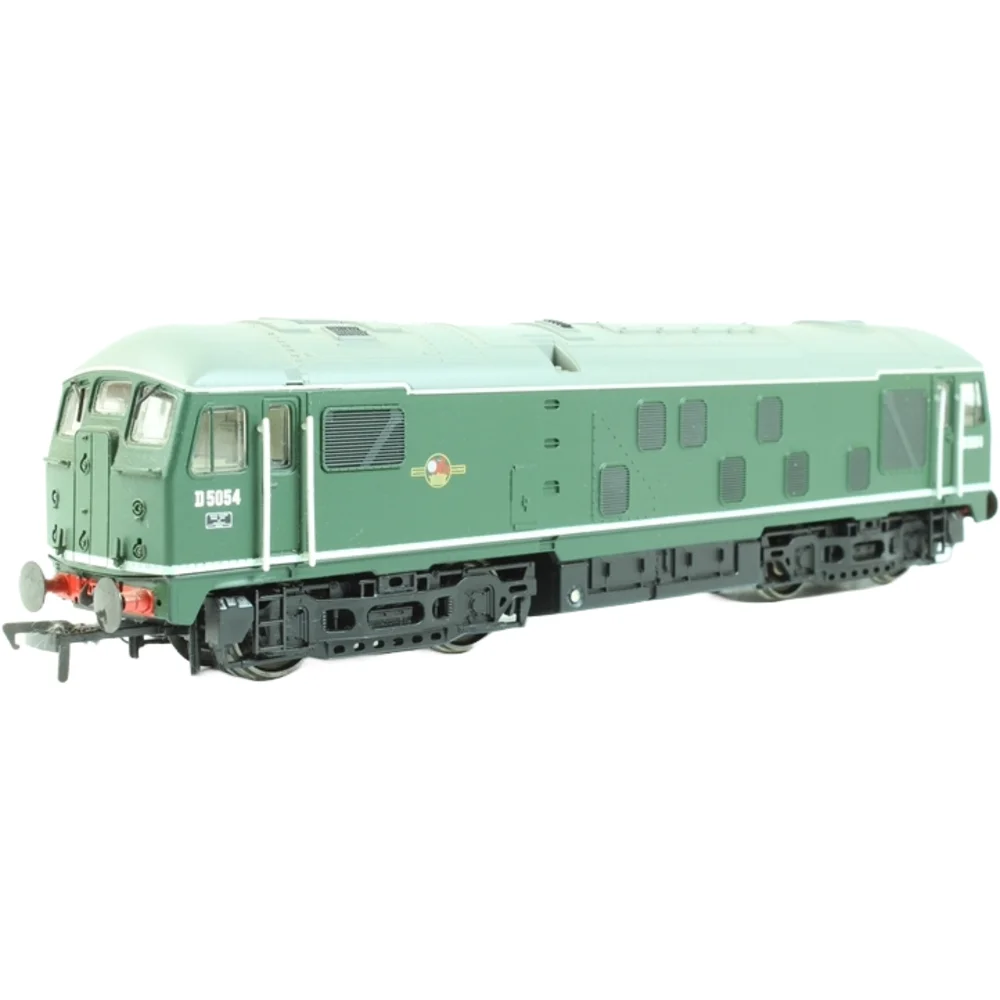Bachmann 32-426
British Rail Class 24 D5054 British Railways Green with Late Crest
Tooling
In 2001, Bachmann Branchline introduced its first ready-to-run model of the British Rail Class 24 diesel-electric locomotive in OO gauge (1:76 scale). This release marked a significant step forward in the representation of BR’s Sulzer Type 2 locomotives, offering modellers a detailed and accessible alternative to kit-built or heavily modified models. The Class 24 tooling was based on the early disc headcode variant (Class 24/0), reflecting locomotives built between 1958 and 1961.
Tooling Features
The model was constructed using a combination of plastic and metal components. It featured separately fitted handrails, lamp irons, glazing with wipers, and fine underframe detailing including footsteps, fuel tanks, and sanding gear. Sprung buffers and tension lock couplings were standard, with cosmetic hooks included. The bufferbeam detailing was supplied in a separate pack, allowing users to customise their models further.
Mechanical & Electrical
Mechanically, the model was powered by a centrally mounted can motor with twin flywheels, driving all eight wheels. Electrical pickup was provided on all wheels, and the model operated on standard 2-rail DC. The minimum radius for operation was second radius (438mm), making it suitable for most layouts. Weighting was built into the chassis to aid traction.
DCC Capability
The 2001 tooling was DCC Ready, equipped with an 8-pin socket. While not sound-fitted from the factory, the model could be upgraded with aftermarket decoders and speakers. Some users fitted Howes or Zimo sound decoders, with varying results depending on speaker choice and installation method.
Liveries Produced
Initial liveries included:
- BR Green with Late Crest
- BR Blue
- Two-Tone Green
These liveries covered a broad operational era from the late 1950s through to the 1980s, allowing modellers to represent a variety of regional allocations and duties.
Reviews & Commentary
Reception of the 2001 tooling was generally positive. Modellers praised its smooth running and solid construction, though some noted minor shape inaccuracies around the cab windows. The model was considered a good runner with excellent slow-speed performance. Enthusiasts appreciated the detailing for its time, though later models from other manufacturers would surpass it in fidelity. Online forums such as RMweb and personal blogs documented user modifications, including lighting upgrades and body swaps to improve accuracy.
Media & Social Media
The model featured in various YouTube reviews and layout demonstrations, often showcasing its running qualities and sound upgrades. While not as heavily promoted as later releases, it maintained a steady presence in the modelling community and was frequently recommended for beginners and intermediate modellers.
Additional Notes
The tooling was lightly updated in 2002, retaining the same core features. It remained in production until the 2008 retooling introduced a 21-pin DCC socket and enhanced detailing. The original 2001 tooling remains a popular choice on the second-hand market and is often used as a base for conversions and customisations.
Class & Prototype
- Class: British Rail Class 24
- Traction: Diesel
- Transmission: Electric
- Built: 1958-1967
- Total Built: 151
- Running Number: D5054
Operator & Livery
- Operator: British Railways
- Livery: Green with Late Crest
- Era: 5 - British Railways Late Crest
British Railways transformed Britain's fragmented rail network into a unified national system following nationalisation on 1st January 1948. Created from the "Big Four" companies under the Transport Act 1947, BR operated most of Great Britain's railways until rebranding as British Rail in 1965, managing over 20,000 route miles and inheriting nearly 20,000 locomotives of diverse designs.
The organisation pioneered standardisation through its revolutionary BR Standard locomotive programme (1951-1960), producing 999 advanced steam engines under Robert Riddles' direction. These included the versatile Britannia Pacifics, mighty 9F freight engines, and mixed-traffic classes that incorporated the best features from all predecessor companies. The 1955 Modernisation Plan accelerated diesel and electric traction development, creating fascinating mixed-traction operations.
Notable achievements included establishing unified locomotive classification systems, introducing distinctive corporate liveries, and managing the complex transition from steam to modern traction. BR's six regional structure preserved operational diversity whilst enabling standardisation of practices, signalling, and rolling stock that had eluded private enterprise for over a century.
The BR era represents steam traction's final flowering alongside emerging diesel technology, creating unparalleled locomotive variety. Today, this heritage remains highly popular with railway enthusiasts through extensive preserved fleets, heritage railway operations, and comprehensive model ranges from manufacturers like Hornby, Bachmann, and Dapol, making BR subjects essential for authentic post-war British railway modelling across all scales.
